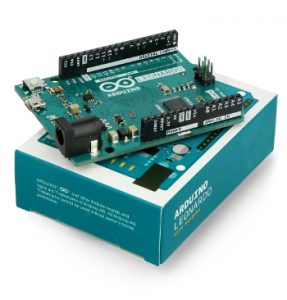Table of Contents:
In order to understand the differences, between the two things one must first characterize them a bit.
Arduino Uno first…
Arduino UNO is mostly considered as a suitable platform for beginners in electronics and programming. It’s often the first Arduino we get our hands on. However, this does not mean that UNO is strictly limited in its capabilities. It is used for many purposes and can be effectively used for smaller projects, although it is not as handy as the Nano series. We should pay just as much attention to the Arduino Leonardo released . The name itself says nothing – it’s basically an ATmega 32U4 microcontroller with built-in USB and crystal oscillator. The key differences and comparisons between Arduino Leonardo and UNO are simple to understand.

…then Leonardo…
Arduino Leonardo was released to the world in the summer of 2012. This happened two years after the September 2012 release of UNO. Initially, the ATmega32U4-based board did not generate enthusiasm. Many seem not to recognize the Arduino Leonardo at all, or rather not to consider it properly for… hmm, anything. However, Leonardo has a significant hardware advantage over UNO, which begs the question: why is it not equally popular? Let’s take a closer look.
- Microcontroller ATmega32u4
- Operating voltage 5V
- Recommended input voltage 7-12V
- Input voltage (limitations) 6-20V
- Digital I/O pins 20
- PWM channels 7
- Analog input channels 12
- DC current per I/O pin 40mA
- DC current for 3.3V pin 50mA
- Flash 32 KB, 4 KB used by bootloader
- SRAM 2.5 KB
- EEPROM 1 KB
- Clock speed 16 MHz
- Other features include a power jack, ISCP jack and reset button.

…and both together
| Arduino Leonardo | Arduino Uno | |
|---|---|---|
| Microcontroller | ATmega32u4 | ATmega328 |
| Digital pins | 20 | 14 |
| Analog pins | 12 | 6 |
| PWM | 7 | 6 |
| Flash | 32 KB, 4 KB for bootloader | 32 KB, 0,5 KB for bootloader |
| SRAM | 2.5 KB | 2 KB |
The differences are significant at first glance. The USB peripherals provide the ATmega32u4 with two major differences from the ATmega328P – the 32u4 bootloader no longer needs to use another serial interface hardware chip, so these pins are free to communicate with external devices or with other microcontrollers. We actually get more of everything. The Arduino Leonardo has more analog pins, where A0-A5 are dedicated to analog pins and A6-A11 are on digital pins. In terms of input and output pins: Arduino Leonardo allows us to use 20 pins compared to 14 in UNO, as it can use analog pins as I/O. In addition, we have an extra PWN pin and a bit more SRAM for faster data access.
The secret to the popularity gap.
Arduino UNO > Leonardo, but is it for sure?
As our partners at Seeedstudio has noticed, there are 3 main reasons, at least.
1. Earlier release date (2010 compared to 2012) and benchmark for development boards. Released 2 years before the Arduino Leonardo, the Uno board has become somewhat of a standard in the development board industry due to its unique pin layout that makes it compatible with most available Arduino Shields. Its ease of use and above average specification set it apart and it rose to the top.

2. Everyone gets stuck sometimes… It’s easier to find tutorials online for Uno. With popularity comes a larger community with more support. Uno tutorials are easily available online, but some of them are not compatible with Leonardo.
3. incompatibility of Arduino Leonardo with Uno Shields. Arduino Uno is known for its wide compatibility with many shields, which are themselves created to fit the board. This is not the case with the Leonardo. Old Arduino shields that we own may have problems working with the Arduino Leonardo. There is no shortage of reports of this in the community.
In theory, everything looks like one big proof not only that the Uno is a much more popular choice, but that it should be. The Arduino Leonardo is, however:
- better performance,
- more USB support,
- no external USB interface chip,
- more flexibility in implementing protocols other than serial UART,
- simply lower price.
As always, the choice is up to you. In case of any doubts feel free to contact us by email or phone.
How useful was this post?
Click on a star to rate it!
Average rating 4.2 / 5. Vote count: 11
No votes so far! Be the first to rate this post.



















